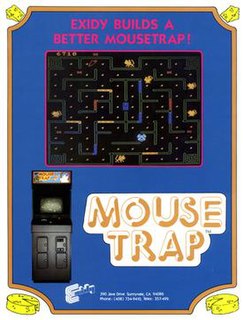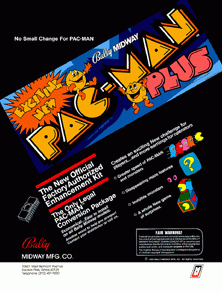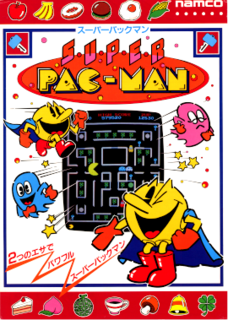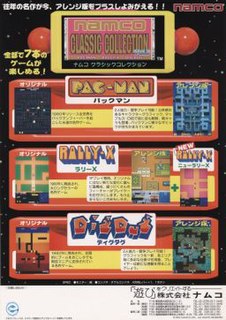External links
| Wikiquote has quotations related to: Thief (arcade game) |
| Thief | |
|---|---|
| Developer(s) | Pacific Novelty |
| Publisher(s) | Pacific Novelty |
| Platform(s) | Arcade |
| Release | 1981 |
| Genre(s) | Maze |
| Mode(s) | Up to 2 players, alternating turns |
Thief is a 1981 arcade video game that is extremely similar to Pac-Man .
The player operates a car being pursued by several blue police cars, in a maze that is supposed to represent city streets. There are eight mazes in all, which change every level in a set order, then repeat starting with the ninth screen. The ninth through sixteenth levels are identical to the first through eighth, except the cars all move faster and the dollar signs (see next paragraph) don't last as long. After that, the game loops back to Level 9, even identifying it as such (i.e., the seventeenth stage says "Level 9 completed!" when cleared). Mazes can have up to three side tunnels that the cars can use to go from one side of the screen to the other, but a few have no tunnels at all.
Each maze is littered with dollar bills which the player collects by running over them. There are also several (usually four, but the first maze configuration has five) golden dollar signs placed throughout the mazes (the equivalent of Pac-Man's energizers); hitting one of these causes the police cars to temporarily turn red. While the police cars are red the player can crash into them and score extra points (100 for the first, 500 for the second, 1000 for the third, and 2000 for the fourth); if contact with the police cars occurs at any other time the player loses a life. When all the dollar bills on one screen have been collected, the player advances to the next level.
As the player clears screens, he receives a new title. There are sixteen titles in all:
Thief was notable for using tape-recorded sounds (on an actual tape player in the machine) masquerading as police radio communications as part of its sound effects (in addition to game-generated sound effects), which ran in a continuous loop while the game was played. Contrary to claims on various websites (for example, Killer List of Video Games), this is not actual police chatter, and this becomes more and more apparent as the chatter goes on, as the voices ham it up more and more, as well as directly taunt the player. According to various street names that are mentioned in the audio, such as Hollywood and Vine, the game is set in Los Angeles. Similar tape loops were used in some of Pacific Novelty's other games: NATO Defense and Shark Attack.
| Wikiquote has quotations related to: Thief (arcade game) |

A sound effect is an artificially created or enhanced sound, or sound process used to emphasize artistic or other content of films, television shows, live performance, animation, video games, music, or other media. Traditionally, in the twentieth century, they were created with foley. In motion picture and television production, a sound effect is a sound recorded and presented to make a specific storytelling or creative point without the use of dialogue or music. The term often refers to a process applied to a recording, without necessarily referring to the recording itself. In professional motion picture and television production, dialogue, music, and sound effects recordings are treated as separate elements. Dialogue and music recordings are never referred to as sound effects, even though the processes applied to such as reverberation or flanging effects, often are called "sound effects".

Pac-Man is a 1980 maze action video game developed and released by Namco for arcades. The original Japanese title of Puck Man was changed to Pac-Man for international releases as a preventative measure against defacement of the arcade machines by changing the P to an F. In North America, the game was released by Midway Manufacturing as part of its licensing agreement with Namco America. The player controls Pac-Man, who must eat all the dots inside an enclosed maze while avoiding four colored ghosts. Eating large flashing dots called "Power Pellets" causes the ghosts to turn blue, allowing Pac-Man to eat them for bonus points.

Ms. Pac-Man is a 1982 maze arcade game developed by General Computer Corporation and published by Midway. It is the first sequel to Pac-Man (1980) and the first entry in the series to not be made by Namco. Controlling the titular character, the player is tasked with eating all of the pellets in an enclosed maze while avoiding four colored ghosts. Eating the larger "power pellets" lets the player eat the ghosts, who turn blue and flee.

Mouse Trap is a 1981 arcade maze game developed by Exidy. The game design is similar to Pac-Man, replacing Pac-Man with a mouse, the dots with cheese, the ghosts with cats, and the power pellets with bones. The unique element of Mouse Trap is that color-coded doors in the maze can be toggled by pressing a button of the same color.

Pac-Man Plus is an arcade game that was released by Bally Midway on March 13, 1982, and it is the third title in the Pac-Man series of games.

Jr. Pac-Man is an arcade game, developed by General Computer Corporation and released by Bally Midway on August 13, 1983. Unlike prior games in the series, the maze in Jr. Pac-Man scrolls horizontally and has no escape tunnels.

Super Pac-Man is a 1982 maze chase arcade game developed and published by Namco and distributed in North America by Midway Games. The game is Namco's take on a sequel to the original Pac-Man (1980); Midway had previously released Ms. Pac-Man (1982), which Namco had little involvement with.

Rally-X is a maze chase arcade game developed and released by Namco in 1980. Players control a blue Formula One racecar through a series of multi-scrolling levels and must collect yellow flags scattered about. There are enemy red cars that pursue the player in an attempt to collide with them, and there are also boulders that must be avoided. Red cars can be temporarily stunned by laying down smoke screens at the cost of a portion of their fuel.

Amidar is a video game developed by Konami and released in arcades in 1981 by Stern. The format is similar to that of Pac-Man: the player moves around a fixed rectilinear lattice, attempting to visit each location on the board while avoiding the enemies. When each spot has been visited, the player moves to the next level. The game and its name have their roots in the Japanese lot drawing game Amidakuji. The bonus level in Amidar is a nearly exact replication of an Amidakuji game and the way the enemies move conform to the Amidakuji rules; this is referred to in the attract mode as "Amidar movement."

Namco Classic Collection Vol. 2 is a compilation arcade game that was released by Namco in 1996. It is a collection of four popular Namco games: Pac-Man (1980), Rally-X (1980), New Rally-X (1981) and Dig Dug (1982). Alongside the original games, three new "Arrangement" games are included. It is a follow-up to Namco Classic Collection Vol. 1, released in 1995.
Lock 'n' Chase (ロック・ン・チェイス) is a video game developed by Data East and released in arcades in Japan in 1981. It was licensed to Taito for distribution in North America. A maze game, Lock 'n' Chase was Data East's response to Pac-Man. Home versions for the Intellivision and Atari 2600 were published by Mattel in 1982 and an Apple II version in January 1983.

Pac-Man is a 1982 maze video game developed and published by Atari, Inc. under official license by Namco, and an adaptation of the 1980 hit arcade game of the same name. The player controls the title character, who attempts to consume all of the wafers while avoiding four ghosts that pursue him. Eating flashing wafers at the corners of the screen will cause the ghosts to turn blue and flee, allowing Pac-Man to eat them for bonus points.
Snack Attack is a video game created by Dan Illowsky for the Apple II family of computers that was published by Datamost in 1982. The gameplay is very similar to that of Pac-Man, which was released two years earlier.

Trog is a 1990 maze arcade video game developed and published by Midway Manufacturing in North America under the "Bally/Midway" label and later by Williams Electronics in Europe. In the game, players control one of four dinosaurs chased by the titular cavemen. Its gameplay includes elements of Pac-Man—collect all items in a maze, eat a special item to turn the tables on pursuers—but supports up to four players at once. Initially envisioned as a hybrid puzzle/strategy project, its original concept was later reworked into a Pac-Man-like title after poor reception from testers and features claymation graphics, advertised as "Playmation" by Midway. Conversions for the Nintendo Entertainment System and MS-DOS were released by Acclaim Entertainment in 1990 and 1991 respectively, reducing the number of simultaneous players to two. Both the arcade and NES versions garnered positive reception from critics.

Cops 'n' Robbers is a video game published by Atlantis Software in 1985 for the VIC-20 and in virtually identical form on the Commodore 64. It was ported to the Commodore 16 and Commodore Plus/4 (1986), Acorn Electron and BBC Micro (1987), and the Atari 8-bit family (1988). The game was controversial when released as the player takes the role of a robber and must shoot the police.

Munchman is a tabletop electronic game that was released under licence in 1981 in the UK by Grandstand. It is a rebadged version of the Tomy game known as Pac Man in the United States and Puck Man in Japan. The games are all based on Namco's Pac-Man arcade game and use a VFD screen.

Grand Theft Auto is an action-adventure video game developed by DMA Design and published by BMG Interactive. It is the first title of the Grand Theft Auto series and was released in November 1997 for MS-DOS and Microsoft Windows, in December 1997 for the PlayStation and in October 1999 for the Game Boy Color. The game's narrative follows a criminal who climbs in status within the criminal underworld across three fictional cities, inspired by real-life locations. The gameplay is presented from a top-down perspective and takes place within an open-world environment in which the player is not required to perform missions, although they are necessary to progress through the levels.
World's Biggest Pac-Man is a browser game created by an Australian Soap Creative along with Microsoft and Namco-Bandai. It is a Pac-Man game which differs from the original by having multiple players playing together in a series of user-created, customizable and interlocking mazes. The game was announced at the Microsoft MIX Developer Conference on 13 April 2011.